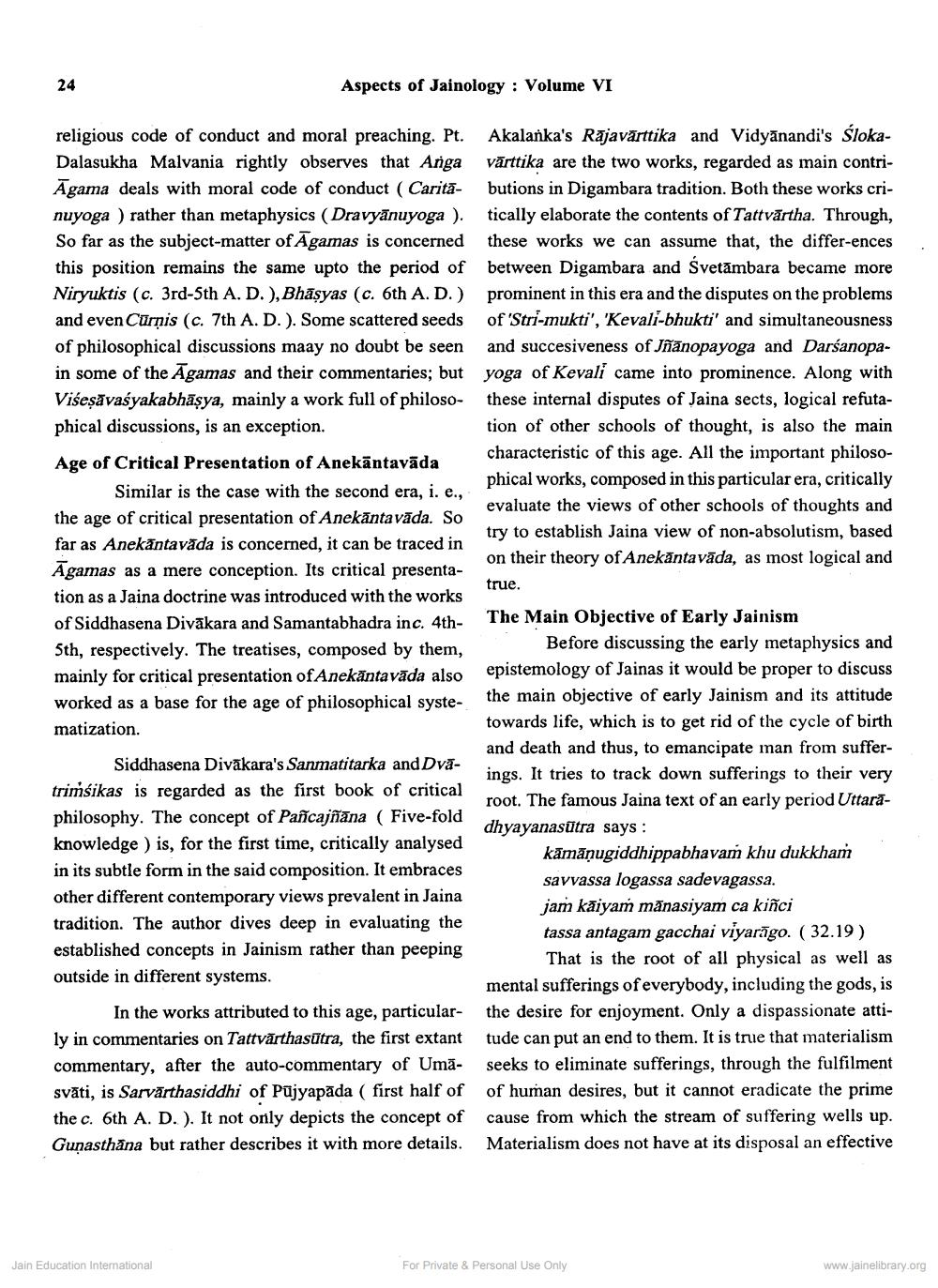Book Title: Historical Development of Jaina Philosophy and Religious Author(s): Sagarmal Jain Publisher: Z_Shwetambar_Sthanakvasi_Jain_Sabha_Hirak_Jayanti_Granth_012052.pdf View full book textPage 3
________________ 24 Aspects of Jainology : Volume VI religious code of conduct and moral preaching. Pt. Akalanka's Rājavārttika and Vidyānandi's ślokaDalasukha Malvania rightly observes that Anga vārttika are the two works, regarded as main contriAgama deals with moral code of conduct ( Caritā- butions in Digambara tradition. Both these works crinuyoga ) rather than metaphysics (Dravyānuyoga ). tically elaborate the contents of Tattvārtha. Through, So far as the subject matter of Āgamas is concerned these works we can assume that, the differ-ences this position remains the same upto the period of between Digambara and Svetambara became more Niryuktis (c. 3rd-Sth A. D. ), Bhāşyas (c. 6th A. D.) prominent in this era and the disputes on the problems and even Cūrnis (c. 7th A. D.). Some scattered seeds of 'Stri-mukti', 'Kevali-bhukti' and simultaneousness of philosophical discussions maay no doubt be seen and succesiveness of Jñānopayoga and Darśanopain some of the Agamas and their commentaries; but yoga of Kevali came into prominence. Along with Višeşāvaśyakabhāșya, mainly a work full of philoso- these internal disputes of Jaina sects, logical refutaphical discussions, is an exception. tion of other schools of thought, is also the main Age of Critical Presentation of Anekāntavāda characteristic of this age. All the important philoso phical works, composed in this particular era, critically Similar is the case with the second era, i. e., evaluate the views of other schools of thoughts and the age of critical presentation of Anekāntavāda. So try to establish Jaina view of non-absolutism, based far as Anekāntavāda is concerned, it can be traced in on their theory of Anekāntavāda, as most logical and Agamas as a mere conception. Its critical presenta true. tion as a Jaina doctrine was introduced with the works of Siddhasena Divākara and Samantabhadra inc. 4th- The Main Objective of Early Jainism The 5th, respectively. The treatises, composed by them, Before discussing the early metaphysics and mainly for critical presentation of Anekantavāda also epistemology of Jainas it would be proper to discuss worked as a base for the age of philosophical syste- the main objective of early Jainism and its attitude matization. towards life, which is to get rid of the cycle of birth and death and thus, to emancipate man from sufferSiddhasena Divākara's Sanmatitarka and Dva ings. It tries to track down sufferings to their very trimśikas is regarded as the first book of critical root. The famous Jaina text of an early period Uttaraphilosophy. The concept of Pañcajñāna ( Five-fold dhyayanasūtra says: knowledge ) is, for the first time, critically analysed kāmāņugiddhippabhavam khu dukkham in its subtle form in the said composition. It embraces savvassa logassa sadevagassa. other different contemporary views prevalent in Jaina jam kāiyaṁ mānasiyam ca kinci tradition. The author dives deep in evaluating the tassa antagam gacchai viyarāgo. ( 32.19) established concepts in Jainism rather than peeping That is the root of all physical as well as outside in different systems. mental sufferings of everybody, including the gods, is In the works attributed to this age, particular- the desire for enjoyment. Only a dispassionate attily in commentaries on Tattvārthasūtra, the first extant tude can put an end to them. It is true that materialism commentary, after the auto-commentary of Umā- seeks to eliminate sufferings, through the fulfilment svāti, is Sarvārthasiddhi of Pūjyapāda ( first half of of human desires, but it cannot eradicate the prime the c. 6th A. D. ). It not only depicts the concept of cause from which the stream of suffering wells up. Gunasthāna but rather describes it with more details. Materialism does not have at its disposal an effective Jain Education International For Private & Personal Use Only www.jainelibrary.orgPage Navigation
1 2 3 4 5 6 7 8 9 10 11 12 13
